Integrated Business Experience: Sandlands Vineyards Case Study
VerifiedAdded on 2023/03/17
|6
|1581
|77
Case Study
AI Summary
This assignment is a case study analysis of Sandlands Vineyards, focusing on Tegan Passalacqua's business decisions and the challenges of the wine industry. The study examines whether Passalacqua should purchase the Eastside Meats building, the attractiveness of the premium wine market, and Sandland's competitive advantages. The analysis considers factors such as market dynamics, customer preferences, production capabilities, and distribution channels, evaluating Sandland's position within the competitive landscape. The case study also explores the financial implications of expanding production and the strategic choices necessary for success in the premium wine market, including leveraging social media and building relationships with growers and distributors. It also touches upon the challenges smaller wineries face in distribution and how Sandland's can capitalize on its premium wine offerings.
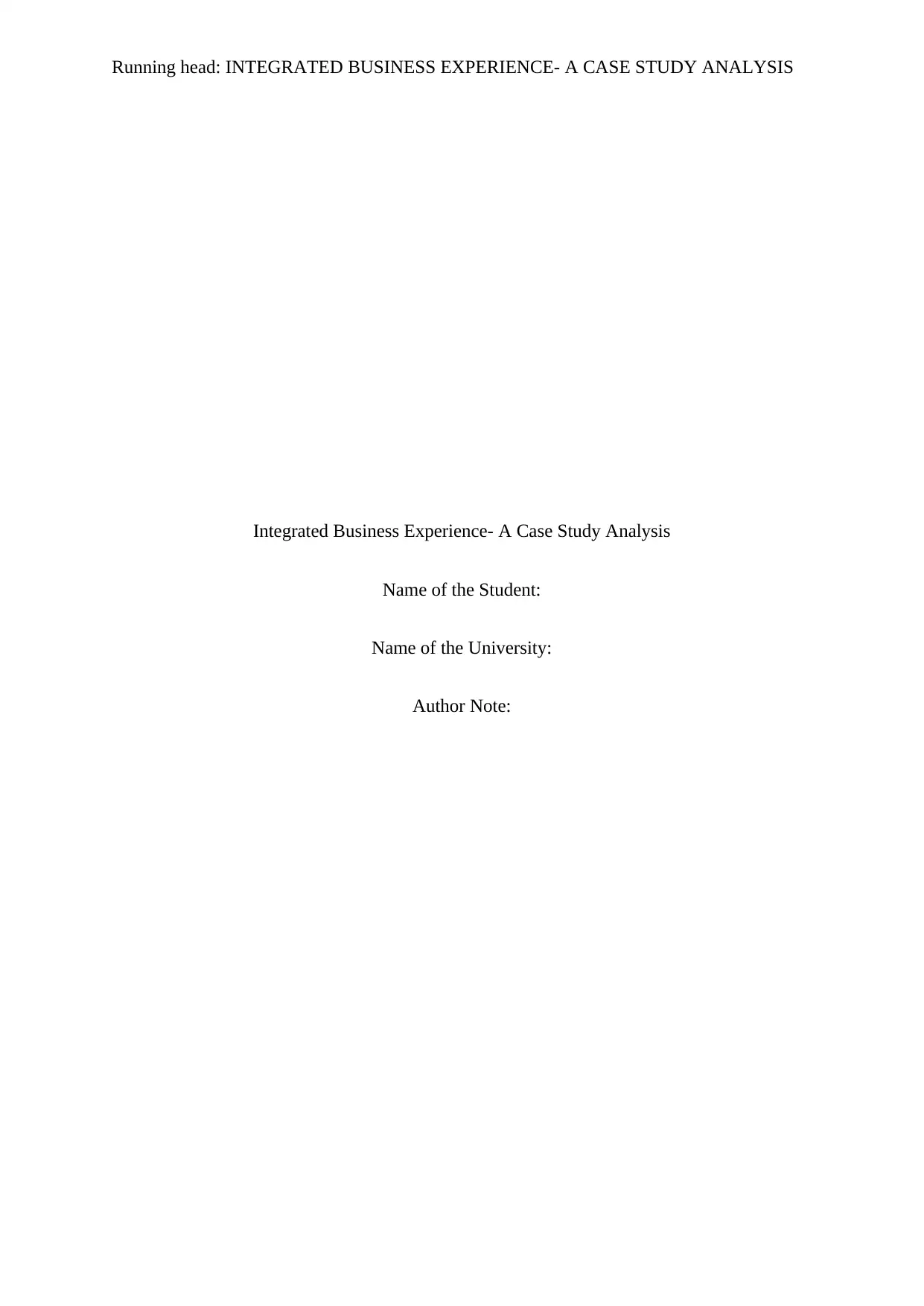
Running head: INTEGRATED BUSINESS EXPERIENCE- A CASE STUDY ANALYSIS
Integrated Business Experience- A Case Study Analysis
Name of the Student:
Name of the University:
Author Note:
Integrated Business Experience- A Case Study Analysis
Name of the Student:
Name of the University:
Author Note:
Paraphrase This Document
Need a fresh take? Get an instant paraphrase of this document with our AI Paraphraser
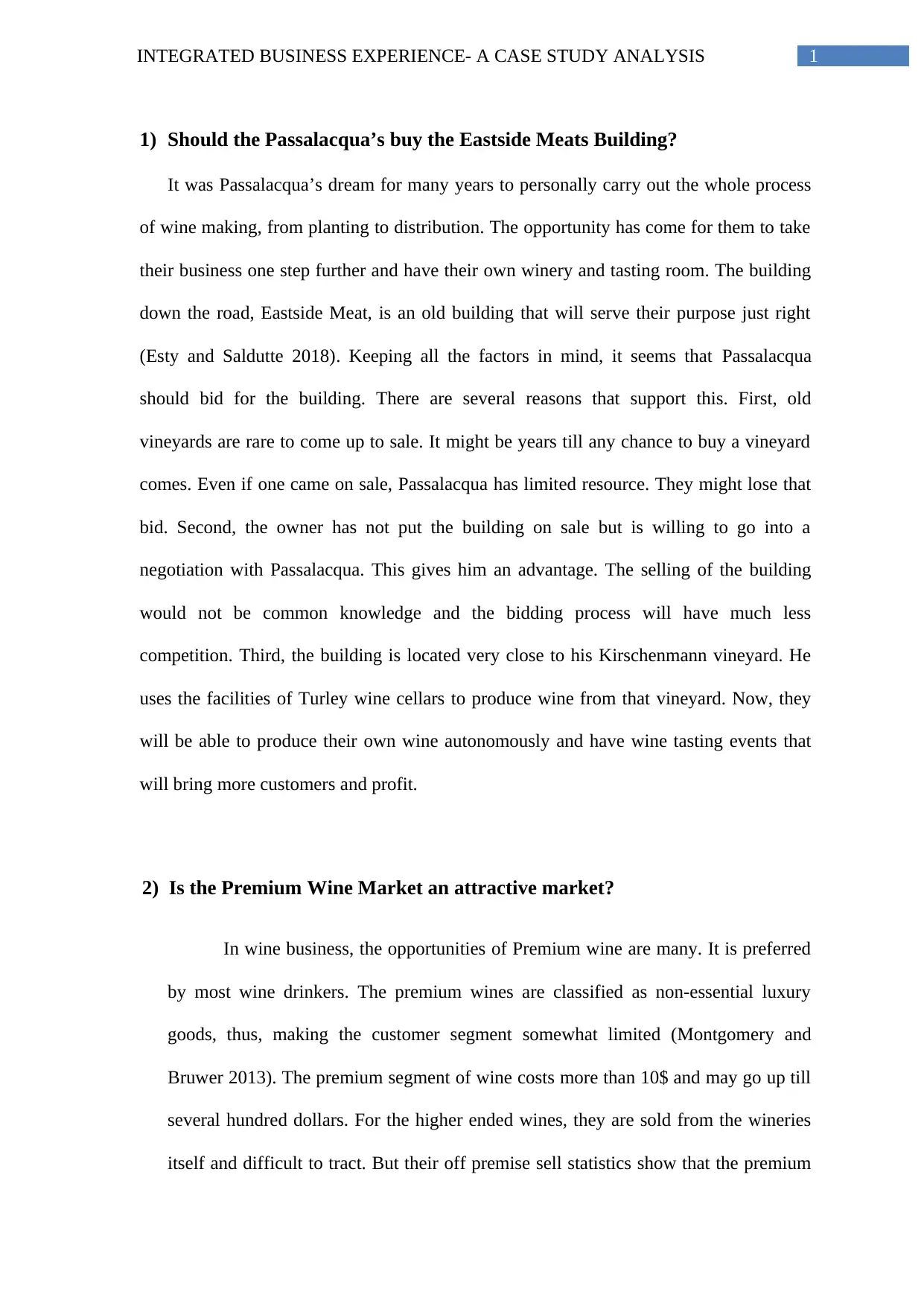
1INTEGRATED BUSINESS EXPERIENCE- A CASE STUDY ANALYSIS
1) Should the Passalacqua’s buy the Eastside Meats Building?
It was Passalacqua’s dream for many years to personally carry out the whole process
of wine making, from planting to distribution. The opportunity has come for them to take
their business one step further and have their own winery and tasting room. The building
down the road, Eastside Meat, is an old building that will serve their purpose just right
(Esty and Saldutte 2018). Keeping all the factors in mind, it seems that Passalacqua
should bid for the building. There are several reasons that support this. First, old
vineyards are rare to come up to sale. It might be years till any chance to buy a vineyard
comes. Even if one came on sale, Passalacqua has limited resource. They might lose that
bid. Second, the owner has not put the building on sale but is willing to go into a
negotiation with Passalacqua. This gives him an advantage. The selling of the building
would not be common knowledge and the bidding process will have much less
competition. Third, the building is located very close to his Kirschenmann vineyard. He
uses the facilities of Turley wine cellars to produce wine from that vineyard. Now, they
will be able to produce their own wine autonomously and have wine tasting events that
will bring more customers and profit.
2) Is the Premium Wine Market an attractive market?
In wine business, the opportunities of Premium wine are many. It is preferred
by most wine drinkers. The premium wines are classified as non-essential luxury
goods, thus, making the customer segment somewhat limited (Montgomery and
Bruwer 2013). The premium segment of wine costs more than 10$ and may go up till
several hundred dollars. For the higher ended wines, they are sold from the wineries
itself and difficult to tract. But their off premise sell statistics show that the premium
1) Should the Passalacqua’s buy the Eastside Meats Building?
It was Passalacqua’s dream for many years to personally carry out the whole process
of wine making, from planting to distribution. The opportunity has come for them to take
their business one step further and have their own winery and tasting room. The building
down the road, Eastside Meat, is an old building that will serve their purpose just right
(Esty and Saldutte 2018). Keeping all the factors in mind, it seems that Passalacqua
should bid for the building. There are several reasons that support this. First, old
vineyards are rare to come up to sale. It might be years till any chance to buy a vineyard
comes. Even if one came on sale, Passalacqua has limited resource. They might lose that
bid. Second, the owner has not put the building on sale but is willing to go into a
negotiation with Passalacqua. This gives him an advantage. The selling of the building
would not be common knowledge and the bidding process will have much less
competition. Third, the building is located very close to his Kirschenmann vineyard. He
uses the facilities of Turley wine cellars to produce wine from that vineyard. Now, they
will be able to produce their own wine autonomously and have wine tasting events that
will bring more customers and profit.
2) Is the Premium Wine Market an attractive market?
In wine business, the opportunities of Premium wine are many. It is preferred
by most wine drinkers. The premium wines are classified as non-essential luxury
goods, thus, making the customer segment somewhat limited (Montgomery and
Bruwer 2013). The premium segment of wine costs more than 10$ and may go up till
several hundred dollars. For the higher ended wines, they are sold from the wineries
itself and difficult to tract. But their off premise sell statistics show that the premium
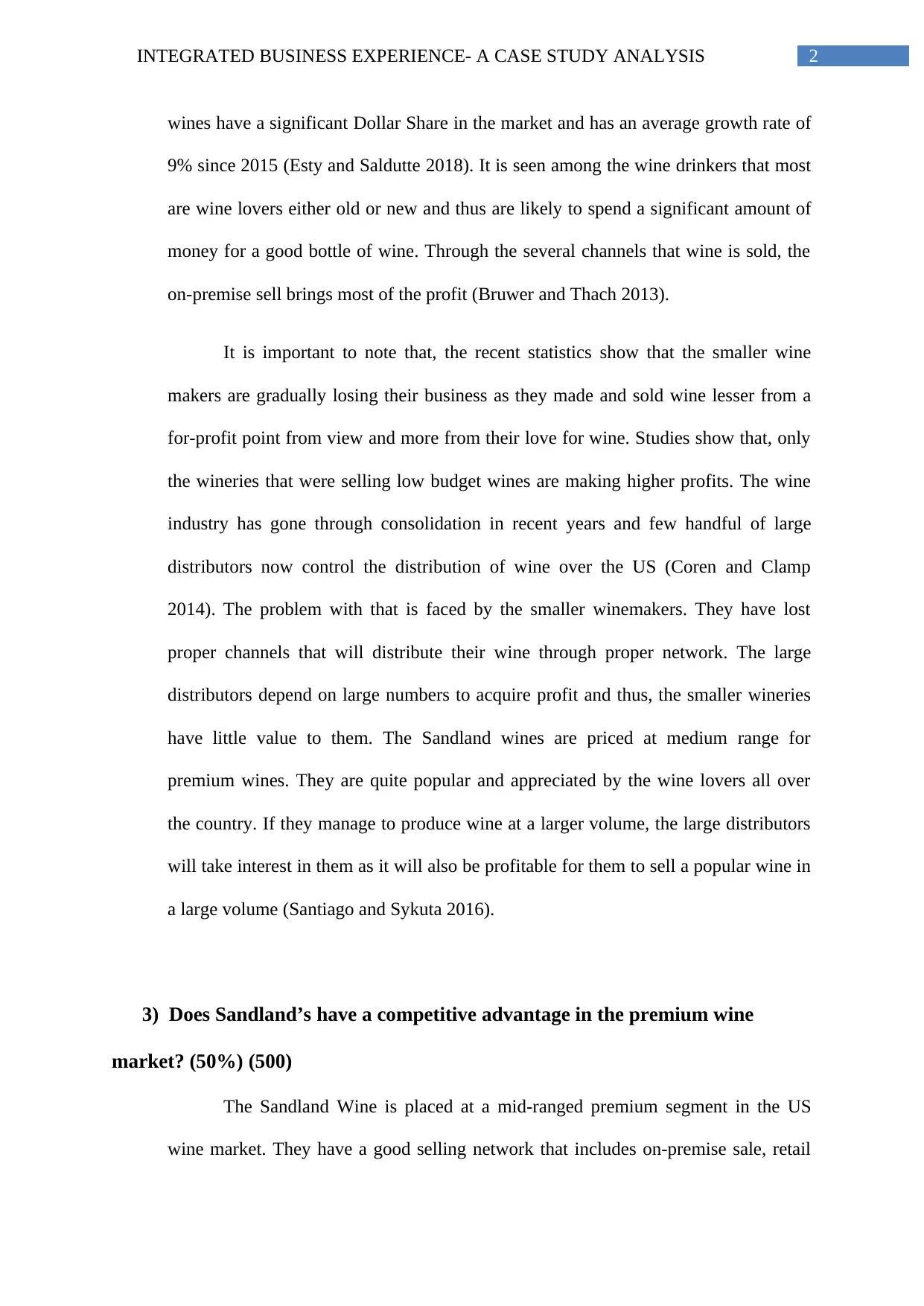
2INTEGRATED BUSINESS EXPERIENCE- A CASE STUDY ANALYSIS
wines have a significant Dollar Share in the market and has an average growth rate of
9% since 2015 (Esty and Saldutte 2018). It is seen among the wine drinkers that most
are wine lovers either old or new and thus are likely to spend a significant amount of
money for a good bottle of wine. Through the several channels that wine is sold, the
on-premise sell brings most of the profit (Bruwer and Thach 2013).
It is important to note that, the recent statistics show that the smaller wine
makers are gradually losing their business as they made and sold wine lesser from a
for-profit point from view and more from their love for wine. Studies show that, only
the wineries that were selling low budget wines are making higher profits. The wine
industry has gone through consolidation in recent years and few handful of large
distributors now control the distribution of wine over the US (Coren and Clamp
2014). The problem with that is faced by the smaller winemakers. They have lost
proper channels that will distribute their wine through proper network. The large
distributors depend on large numbers to acquire profit and thus, the smaller wineries
have little value to them. The Sandland wines are priced at medium range for
premium wines. They are quite popular and appreciated by the wine lovers all over
the country. If they manage to produce wine at a larger volume, the large distributors
will take interest in them as it will also be profitable for them to sell a popular wine in
a large volume (Santiago and Sykuta 2016).
3) Does Sandland’s have a competitive advantage in the premium wine
market? (50%) (500)
The Sandland Wine is placed at a mid-ranged premium segment in the US
wine market. They have a good selling network that includes on-premise sale, retail
wines have a significant Dollar Share in the market and has an average growth rate of
9% since 2015 (Esty and Saldutte 2018). It is seen among the wine drinkers that most
are wine lovers either old or new and thus are likely to spend a significant amount of
money for a good bottle of wine. Through the several channels that wine is sold, the
on-premise sell brings most of the profit (Bruwer and Thach 2013).
It is important to note that, the recent statistics show that the smaller wine
makers are gradually losing their business as they made and sold wine lesser from a
for-profit point from view and more from their love for wine. Studies show that, only
the wineries that were selling low budget wines are making higher profits. The wine
industry has gone through consolidation in recent years and few handful of large
distributors now control the distribution of wine over the US (Coren and Clamp
2014). The problem with that is faced by the smaller winemakers. They have lost
proper channels that will distribute their wine through proper network. The large
distributors depend on large numbers to acquire profit and thus, the smaller wineries
have little value to them. The Sandland wines are priced at medium range for
premium wines. They are quite popular and appreciated by the wine lovers all over
the country. If they manage to produce wine at a larger volume, the large distributors
will take interest in them as it will also be profitable for them to sell a popular wine in
a large volume (Santiago and Sykuta 2016).
3) Does Sandland’s have a competitive advantage in the premium wine
market? (50%) (500)
The Sandland Wine is placed at a mid-ranged premium segment in the US
wine market. They have a good selling network that includes on-premise sale, retail
⊘ This is a preview!⊘
Do you want full access?
Subscribe today to unlock all pages.

Trusted by 1+ million students worldwide
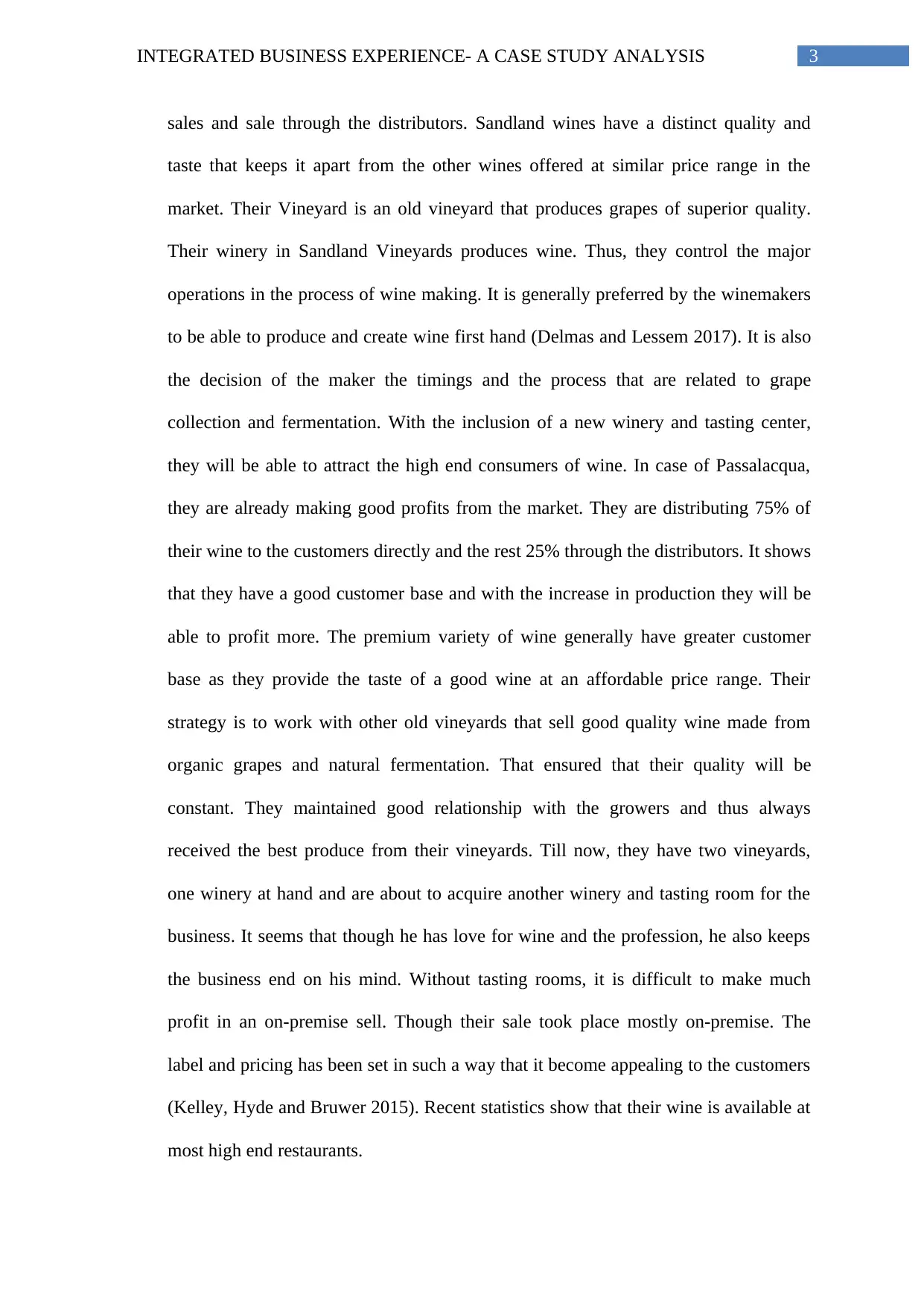
3INTEGRATED BUSINESS EXPERIENCE- A CASE STUDY ANALYSIS
sales and sale through the distributors. Sandland wines have a distinct quality and
taste that keeps it apart from the other wines offered at similar price range in the
market. Their Vineyard is an old vineyard that produces grapes of superior quality.
Their winery in Sandland Vineyards produces wine. Thus, they control the major
operations in the process of wine making. It is generally preferred by the winemakers
to be able to produce and create wine first hand (Delmas and Lessem 2017). It is also
the decision of the maker the timings and the process that are related to grape
collection and fermentation. With the inclusion of a new winery and tasting center,
they will be able to attract the high end consumers of wine. In case of Passalacqua,
they are already making good profits from the market. They are distributing 75% of
their wine to the customers directly and the rest 25% through the distributors. It shows
that they have a good customer base and with the increase in production they will be
able to profit more. The premium variety of wine generally have greater customer
base as they provide the taste of a good wine at an affordable price range. Their
strategy is to work with other old vineyards that sell good quality wine made from
organic grapes and natural fermentation. That ensured that their quality will be
constant. They maintained good relationship with the growers and thus always
received the best produce from their vineyards. Till now, they have two vineyards,
one winery at hand and are about to acquire another winery and tasting room for the
business. It seems that though he has love for wine and the profession, he also keeps
the business end on his mind. Without tasting rooms, it is difficult to make much
profit in an on-premise sell. Though their sale took place mostly on-premise. The
label and pricing has been set in such a way that it become appealing to the customers
(Kelley, Hyde and Bruwer 2015). Recent statistics show that their wine is available at
most high end restaurants.
sales and sale through the distributors. Sandland wines have a distinct quality and
taste that keeps it apart from the other wines offered at similar price range in the
market. Their Vineyard is an old vineyard that produces grapes of superior quality.
Their winery in Sandland Vineyards produces wine. Thus, they control the major
operations in the process of wine making. It is generally preferred by the winemakers
to be able to produce and create wine first hand (Delmas and Lessem 2017). It is also
the decision of the maker the timings and the process that are related to grape
collection and fermentation. With the inclusion of a new winery and tasting center,
they will be able to attract the high end consumers of wine. In case of Passalacqua,
they are already making good profits from the market. They are distributing 75% of
their wine to the customers directly and the rest 25% through the distributors. It shows
that they have a good customer base and with the increase in production they will be
able to profit more. The premium variety of wine generally have greater customer
base as they provide the taste of a good wine at an affordable price range. Their
strategy is to work with other old vineyards that sell good quality wine made from
organic grapes and natural fermentation. That ensured that their quality will be
constant. They maintained good relationship with the growers and thus always
received the best produce from their vineyards. Till now, they have two vineyards,
one winery at hand and are about to acquire another winery and tasting room for the
business. It seems that though he has love for wine and the profession, he also keeps
the business end on his mind. Without tasting rooms, it is difficult to make much
profit in an on-premise sell. Though their sale took place mostly on-premise. The
label and pricing has been set in such a way that it become appealing to the customers
(Kelley, Hyde and Bruwer 2015). Recent statistics show that their wine is available at
most high end restaurants.
Paraphrase This Document
Need a fresh take? Get an instant paraphrase of this document with our AI Paraphraser
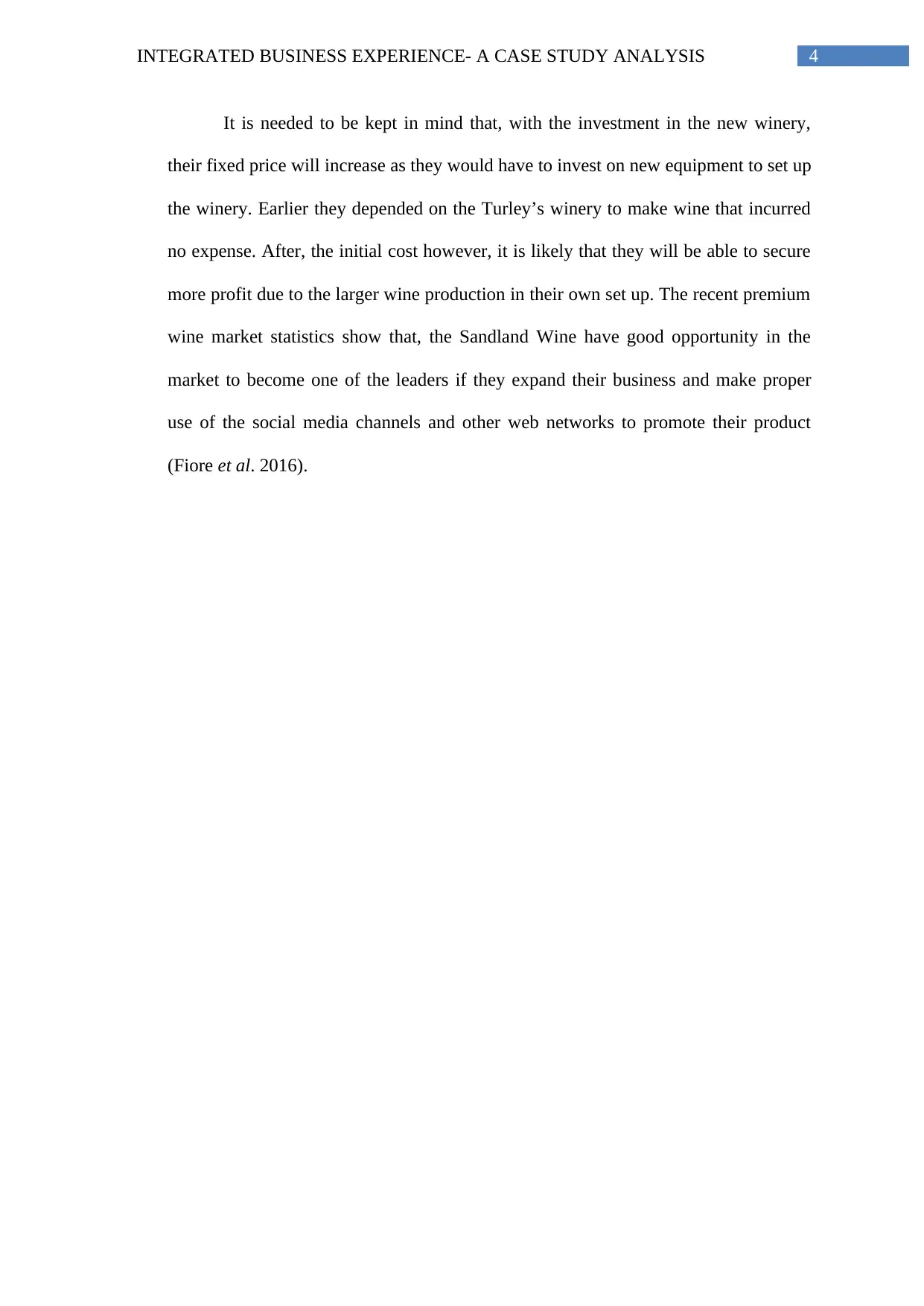
4INTEGRATED BUSINESS EXPERIENCE- A CASE STUDY ANALYSIS
It is needed to be kept in mind that, with the investment in the new winery,
their fixed price will increase as they would have to invest on new equipment to set up
the winery. Earlier they depended on the Turley’s winery to make wine that incurred
no expense. After, the initial cost however, it is likely that they will be able to secure
more profit due to the larger wine production in their own set up. The recent premium
wine market statistics show that, the Sandland Wine have good opportunity in the
market to become one of the leaders if they expand their business and make proper
use of the social media channels and other web networks to promote their product
(Fiore et al. 2016).
It is needed to be kept in mind that, with the investment in the new winery,
their fixed price will increase as they would have to invest on new equipment to set up
the winery. Earlier they depended on the Turley’s winery to make wine that incurred
no expense. After, the initial cost however, it is likely that they will be able to secure
more profit due to the larger wine production in their own set up. The recent premium
wine market statistics show that, the Sandland Wine have good opportunity in the
market to become one of the leaders if they expand their business and make proper
use of the social media channels and other web networks to promote their product
(Fiore et al. 2016).
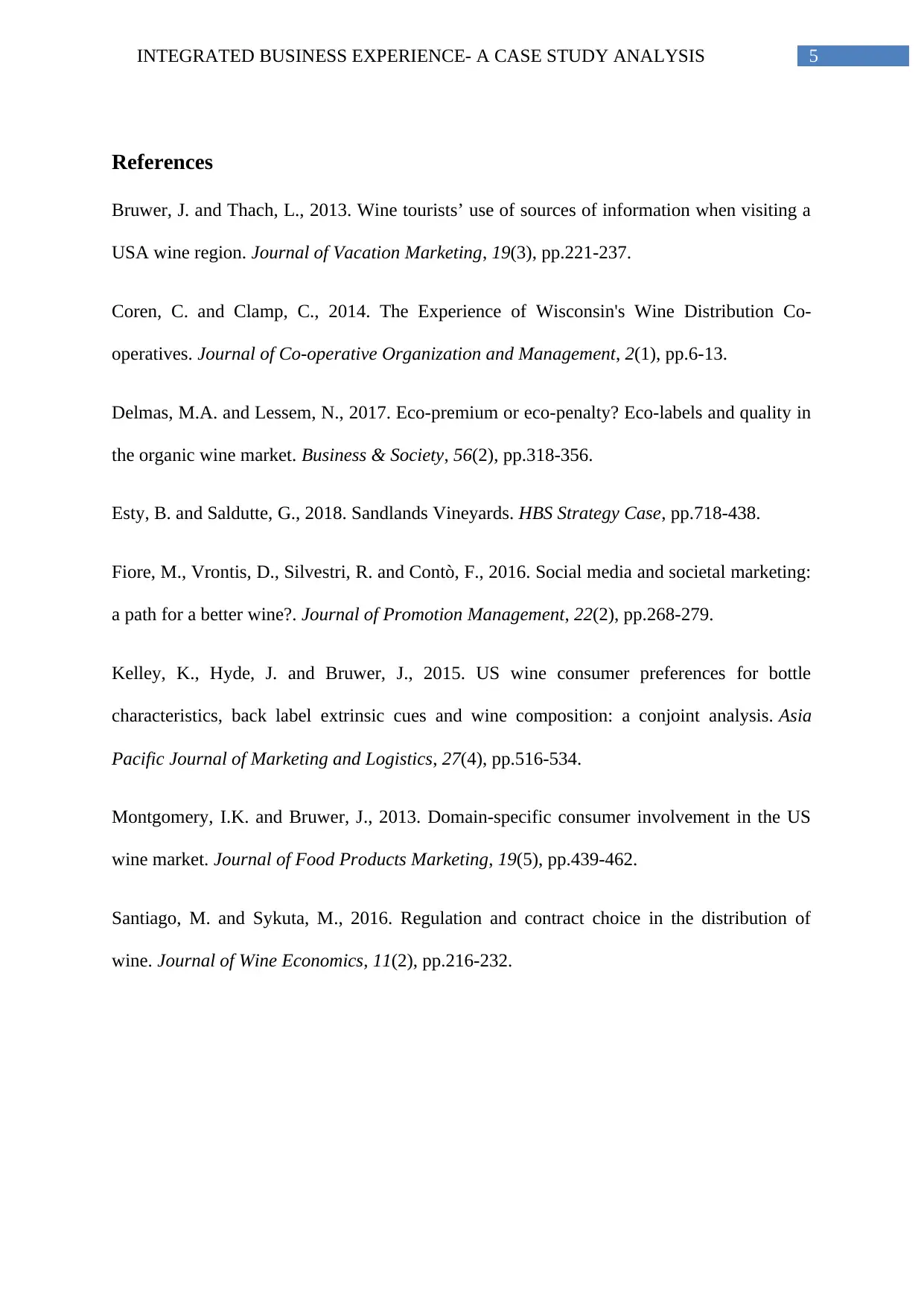
5INTEGRATED BUSINESS EXPERIENCE- A CASE STUDY ANALYSIS
References
Bruwer, J. and Thach, L., 2013. Wine tourists’ use of sources of information when visiting a
USA wine region. Journal of Vacation Marketing, 19(3), pp.221-237.
Coren, C. and Clamp, C., 2014. The Experience of Wisconsin's Wine Distribution Co-
operatives. Journal of Co-operative Organization and Management, 2(1), pp.6-13.
Delmas, M.A. and Lessem, N., 2017. Eco-premium or eco-penalty? Eco-labels and quality in
the organic wine market. Business & Society, 56(2), pp.318-356.
Esty, B. and Saldutte, G., 2018. Sandlands Vineyards. HBS Strategy Case, pp.718-438.
Fiore, M., Vrontis, D., Silvestri, R. and Contò, F., 2016. Social media and societal marketing:
a path for a better wine?. Journal of Promotion Management, 22(2), pp.268-279.
Kelley, K., Hyde, J. and Bruwer, J., 2015. US wine consumer preferences for bottle
characteristics, back label extrinsic cues and wine composition: a conjoint analysis. Asia
Pacific Journal of Marketing and Logistics, 27(4), pp.516-534.
Montgomery, I.K. and Bruwer, J., 2013. Domain-specific consumer involvement in the US
wine market. Journal of Food Products Marketing, 19(5), pp.439-462.
Santiago, M. and Sykuta, M., 2016. Regulation and contract choice in the distribution of
wine. Journal of Wine Economics, 11(2), pp.216-232.
References
Bruwer, J. and Thach, L., 2013. Wine tourists’ use of sources of information when visiting a
USA wine region. Journal of Vacation Marketing, 19(3), pp.221-237.
Coren, C. and Clamp, C., 2014. The Experience of Wisconsin's Wine Distribution Co-
operatives. Journal of Co-operative Organization and Management, 2(1), pp.6-13.
Delmas, M.A. and Lessem, N., 2017. Eco-premium or eco-penalty? Eco-labels and quality in
the organic wine market. Business & Society, 56(2), pp.318-356.
Esty, B. and Saldutte, G., 2018. Sandlands Vineyards. HBS Strategy Case, pp.718-438.
Fiore, M., Vrontis, D., Silvestri, R. and Contò, F., 2016. Social media and societal marketing:
a path for a better wine?. Journal of Promotion Management, 22(2), pp.268-279.
Kelley, K., Hyde, J. and Bruwer, J., 2015. US wine consumer preferences for bottle
characteristics, back label extrinsic cues and wine composition: a conjoint analysis. Asia
Pacific Journal of Marketing and Logistics, 27(4), pp.516-534.
Montgomery, I.K. and Bruwer, J., 2013. Domain-specific consumer involvement in the US
wine market. Journal of Food Products Marketing, 19(5), pp.439-462.
Santiago, M. and Sykuta, M., 2016. Regulation and contract choice in the distribution of
wine. Journal of Wine Economics, 11(2), pp.216-232.
⊘ This is a preview!⊘
Do you want full access?
Subscribe today to unlock all pages.

Trusted by 1+ million students worldwide
1 out of 6
Your All-in-One AI-Powered Toolkit for Academic Success.
+13062052269
info@desklib.com
Available 24*7 on WhatsApp / Email
![[object Object]](/_next/static/media/star-bottom.7253800d.svg)
Unlock your academic potential
Copyright © 2020–2025 A2Z Services. All Rights Reserved. Developed and managed by ZUCOL.


